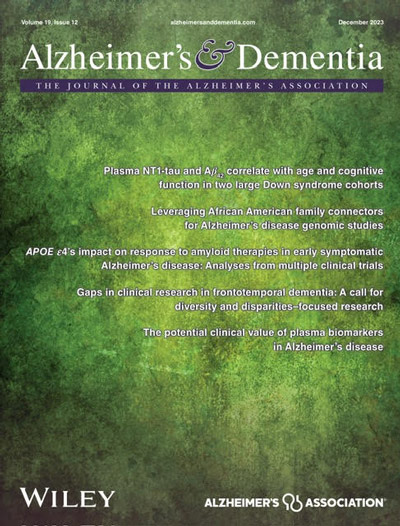脑淀粉样血管病、神经原纤维缠结和神经性斑块共同病理对白质微观结构的影响不同
IF 11.1
1区 医学
Q1 CLINICAL NEUROLOGY
引用次数: 0
摘要
在阿尔茨海默病(AD)中,白质(WM)受神经原纤维缠结(NFT)传播的影响,并作为其途径。脑淀粉样血管病(CAA)与神经性斑块(NPs)相关,可加剧NFT的积累。我们的目标是研究这些共病理如何影响WM完整性。方法:根据参与者死后NFT、NP和CAA神经病理学数据,我们对死前弥散张量成像(DTI)数据进行了横断面研究,这些数据来自国家阿尔茨海默病协调中心的数据集。结果我们发现Braak NFT II期、IV期和V/VI期之间几个WM区域的DTI变化不对称,并且跨越CAA病理负担,平均扩散率、径向扩散率和轴向扩散率增加。CAA - NFT共病理效应主要发生在胼胝体的脾部。DTI指标与认知功能和海马体积相关。我们的研究结果表明,AD神经病理对WM完整性的影响是不同的,CAA和nft相互影响对WM微观结构的影响。弥散张量成像(DTI)在Braak晚期和整个脑淀粉样血管病(CAA)期间观察到几个白质(WM)区域的变化。CAA显示WM对右半球的影响更大,而神经原纤维缠结(nft)对左侧的影响更大。CAA-NFT同时作用主要发生在胼胝体的脾部。WM DTI指标与认知和海马体积相关。本文章由计算机程序翻译,如有差异,请以英文原文为准。
White matter microstructure is differentially impacted by cerebral amyloid angiopathy, neurofibrillary tangles, and neuritic plaque co‐pathology
INTRODUCTIONWhite matter (WM) is affected by and serves as a pathway to neurofibrillary tangle (NFT) propagation in Alzheimer's disease (AD). Cerebral amyloid angiopathy (CAA) associates with neuritic plaques (NPs) to exacerbate NFT accumulation. We aim to study how these co‐pathologies affect WM integrity.METHODSWe performed a cross‐sectional study of ante mortem diffusion tensor imaging (DTI) data according to participants’ post mortem NFT, NP, and CAA neuropathology, from the National Alzheimer's Coordinating Center dataset.RESULTSWe found asymmetric DTI changes in several WM regions between Braak NFT stages II and IV and V/VI, and across CAA pathological burden, with increased mean, radial, and axial diffusivities. CAA‐NFT co‐pathology effects were observed mainly in the splenium of the corpus callosum. DTI metrics were associated with cognitive function and hippocampal volumes.DISCUSSIONOur results suggest that WM integrity is differentially impacted by AD neuropathology, with CAA and NFTs influencing each other's effects on WM microstructure.Highlights Diffusion tensor imaging (DTI) changes were observed in several white matter (WM) regions between advanced Braak stages and across cerebral amyloid angiopathy (CAA). CAA demonstrated a greater WM impact on the right hemisphere, while neurofibrillary tangles (NFTs) had greater impact on the left. CAA–NFT concurrent effects were mainly noticed in the splenium of the corpus callosum. WM DTI metrics were associated with cognition and hippocampal volumes.
求助全文
通过发布文献求助,成功后即可免费获取论文全文。
去求助
来源期刊

Alzheimer's & Dementia
医学-临床神经学
CiteScore
14.50
自引率
5.00%
发文量
299
审稿时长
3 months
期刊介绍:
Alzheimer's & Dementia is a peer-reviewed journal that aims to bridge knowledge gaps in dementia research by covering the entire spectrum, from basic science to clinical trials to social and behavioral investigations. It provides a platform for rapid communication of new findings and ideas, optimal translation of research into practical applications, increasing knowledge across diverse disciplines for early detection, diagnosis, and intervention, and identifying promising new research directions. In July 2008, Alzheimer's & Dementia was accepted for indexing by MEDLINE, recognizing its scientific merit and contribution to Alzheimer's research.
 求助内容:
求助内容: 应助结果提醒方式:
应助结果提醒方式:


